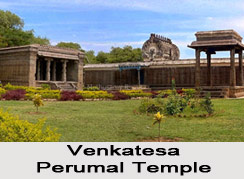 The superb architecture of the contemporary era is evident from the superb artistic carvings imprinted on the temple walls. The wonderful architecture is an added grandeur to the traditional temple. The structural design of the temple is no les fascinating. The entire temple of Sri Venkatesa Perumal faces north. The main shrine is immensely beautiful and is the abode of the charming and imposing image of Lord Venkatesa, the presiding deity of the temple. The unusual posture of lord Venkatesa is an important aspect of interest for those who come to visit the temples. The Lord Sri Venkatesa Perumal is seen in a standing posture, carrying the sankha and chakra with sage Markandeya and Goddess Bhu Devi is found at His feet. It is believed that this deity is a combination of the aspects of Brahma, Vishnu and Siva. Hence this very image carries a special significance for the devotees. The utsava-murti or the processional image of this shrine is known as Lord Srinivasa. This image is highly venerated and the sanctum enshrining this image is considered a sacrosanct.
The superb architecture of the contemporary era is evident from the superb artistic carvings imprinted on the temple walls. The wonderful architecture is an added grandeur to the traditional temple. The structural design of the temple is no les fascinating. The entire temple of Sri Venkatesa Perumal faces north. The main shrine is immensely beautiful and is the abode of the charming and imposing image of Lord Venkatesa, the presiding deity of the temple. The unusual posture of lord Venkatesa is an important aspect of interest for those who come to visit the temples. The Lord Sri Venkatesa Perumal is seen in a standing posture, carrying the sankha and chakra with sage Markandeya and Goddess Bhu Devi is found at His feet. It is believed that this deity is a combination of the aspects of Brahma, Vishnu and Siva. Hence this very image carries a special significance for the devotees. The utsava-murti or the processional image of this shrine is known as Lord Srinivasa. This image is highly venerated and the sanctum enshrining this image is considered a sacrosanct.
The stone carvings are one of the significant feature of the Sri Venkatesa Perumal temple. The stone images of numerous Azhvars and Vaishnava Acharyas are one of the fascinating feature of this temple. Apart from the images of Azhvars and Acharyas the sanctum also houses the exquisite icons of Hanuman and Garuda. These images are found in the mandapa leading to the main sanctum. The shrine of Goddess Alarmelmanga is seen to the right of this mandapa, which is considered immensely consecrated by the devotees. There are two circumambulatory passages in this temple, which is situated on the outskirts of the village located on the bank of the confluence of the rivers. These two circumambulatory passages on the confluence of the river are found to have enhanced the picturesque view of Sri Venkatesa Perumal Temple.





















